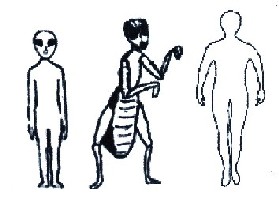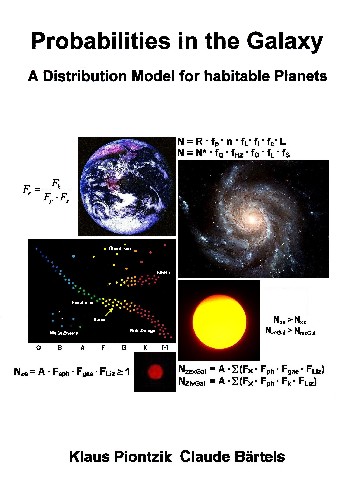 |
There are 13
causes listed that can destroy life on earth
globally. The chance that a species will develop
and survive and develop is therefore 1 in 14.
Only every 14th planet that has life could
produce a species capable of consciousness. This
corresponds to a share of 7.142 %.
The probability factor is then Fi = 0.071,428 = 1:14.
|
If
one looks at the situation rather conservatively, then
only planets come into question, which resemble an
"earth 2".
From the further development of equation 4.2.1 for
habitable earths with life, the number of living
"earths 2" with an intelligent species is as
follows:
| 5.3.1 Equation |
Nie
= NLe ·
Fi
Nie
= A · Fsph ·
Fgae
· FL ·
Fi
Nie
= A · Fs ·
Fp ·
Fh ·
Fg
· Fa ·
Fe ·
FL ·
Fi |
|
Since two values exist for Fe and Fgae
a minimum-maximum statement can be generated here as
well:
case 1 (Fe
= 0.1)
Inserting all values (Fe = 0.1) into equation 5.3.1:
Nie1 = (100-300)·109 ·
1:15,000 · 1:69 · 1:9 · 1:14
Nie1
= 767 – 2,300 „Earth 2“ with intelligent
Life
case 2 (Fe
= 0.01)
Inserting all values (Fe = 0.01) into equation
5.3.1:
Nie2 = (100-300)·109 · 1:15,000
· 1:691 · 1:9 · 1:14
Nie2
= 77 – 230 „Earth 2“ with intelligent Life
The two results can then be summarized to the following
statement:
| 5.3.2 Satz |
The number of solar-like
star systems, with an "Earth 2" in
habitable zones, which have produced an
intelligent species, is probably between 77 and
2,300. |
The
probability for a habitable "Earth 2", with
intelligent life, in solar-like star systems, in our
galaxy, then arises:
| 5.3.3 Definition |
Fie
= Fs ·
Fp
· Fh ·
Fg ·
Fa
· Fe
· FL ·
Fi
Fie
= Fsph
· Fgae ·
FL
· Fi |
Fie = Fsph·Fgae·FL·Fi
Fie= 1:15,000 · (1:69 – 1:691) · 1:9 ·
1:14
Fie= 1:130,410,000 – 1:1,305,990,00
Only every 130.41 millionth to 1.305 billionth
star system has an "Earth 2", with intelligent
life.
|
